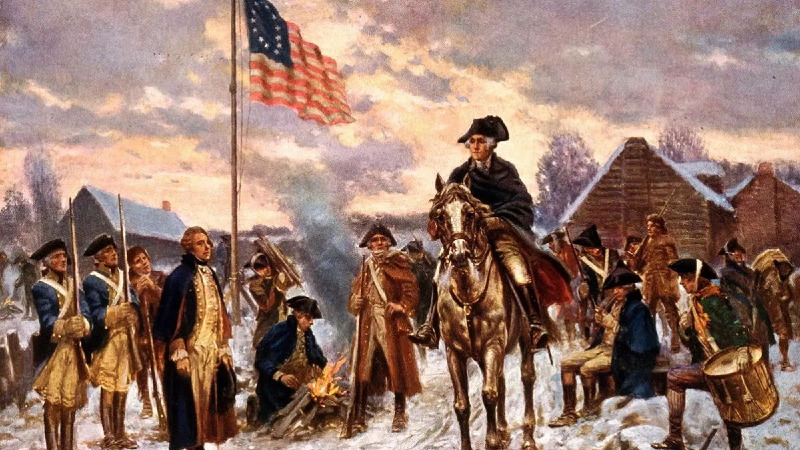
Ragtag Revolutionary Force to Superpower
by Theodore B. Morrison, age 13
The United States military is a dominant power in the modern age. It has the capability to devastate any foe with its bomber squadrons, special forces units, tanks, naval ships, and artillery equipment. Before the turn of the twentieth century, though, the US did not invest much in its military. Looking back, how did the United States rise from a military force of forty-eight thousand soldiers in the Revolutionary War to 1.4 million soldiers today with some of the most advanced technology known to mankind?
The Continental Army, Navy, and Marine Corps, which would become the foundation for the US armed forces, were founded in 1775 at the start of the American Revolution alongside the already existing state and local militias, which would become the National Guard. Over the course of the Revolution, General George Washington led the American army to victory many times, with the help of France and tactical errors from British generals. There were several close calls, but the Americans persevered and scored victories at Trenton and Princeton, New Jersey. Following these defeats in northern cities, the British focused their efforts on the South, conquering Charleston, South Carolina, and Georgia. These victories were short lived as American patriots pestered British loyalists and put a stop to their advance from Canada.
Nearly 80 years later, Americans fought each other in the Civil War. Both the North and the South fought hard, causing a total fatality count of 600,000 on both sides. This made the Civil War more deadly for Americans than World Wars I and II combined. The weapons that caused such large casualties included newly-invented, cone-shaped ammunition, rifles with a range of a quarter of a mile, and multi-shot rifles. Furthermore, American generals also used predictable and outdated strategies that led to additional casualties. One example of these strategies was a large-scale frontal assault on an enemy position. Though the war was brutal, the North prevailed. Following the war, the US military focused on domestic agendas such as Reconstruction in the South and expansion to the west.
In the 1890s, the federal government had little regard for policies or agendas relating to international affairs, military or otherwise. Moral, economic, and military pressures led American politicians to focus on territorial grounds, raw material for production, and opportunities to invest in future projects. Despite politicians’ concerns about exiting an age of isolation, the US engaged in disagreements with Germany, Chile, and Britain. After a conflict with Spain in 1898, the United States gained the territories of Puerto Rico, Guam, and the Philippines. Following the turn of the twentieth century, the US had turned into a world superpower with a handful of territories.
Only 15 years later, the first World War was declared after the assassination of the heir of the Austro-Hungarian empire. The war was the bloodiest in world history at the time and killed nine million combatants and five million civilians. It was also the most financially expensive war at the time with more than $185 billion in direct costs. While the world fought, the US stayed neutral for most of the war until the British intercepted the Zimmerman Note. The note consisted of a letter to the German ambassador in Mexico instructing the ambassador to offer German assistance in regaining control of its lost territory in Texas, New Mexico, California, and Arizona if and when the Americans entered the war. When the US joined the Allied forces of England, France, Italy, Japan, and Russia its manpower and resources hastened the end of the war.
When World War II started in 1939 in Europe, the United States didn’t join immediately. The Japanese attack on Pearl Harbor in 1941 enraged the US. Following the attack, the US quickly declared war on Japan and all of its allies, including Nazi Germany. In 1942, a year after the war started for the US, the Manhattan Project began with the objective of creating the first nuclear bomb. In 1945, the first successful test of the nuclear bomb happened in New Mexico. In August of that same year, two of these devastating bombs destroyed the Japanese cities of Hiroshima and Nagasaki, ending the second world war.
Now, in modern times, the United States still fights in most major wars, most famously the War on Terror, which responded to the infamous attacks on 9/11. In the current age, the US has turned its attention to its naval power. It also focuses on its defense systems to safeguard against missiles aimed at targeting the US mainland, military personnel, and military installations.
The US is a perfect example of a modern military power with the highest military budget in the world. The US has invested billions into the technology necessary to keep up with the current demand of modern warfare. The US military is currently the most technologically advanced armed force in the world, which is astonishing considering its humble beginning.
[Source:
University of Houston: Digital History, MilitarySpot, NewScientist
]

